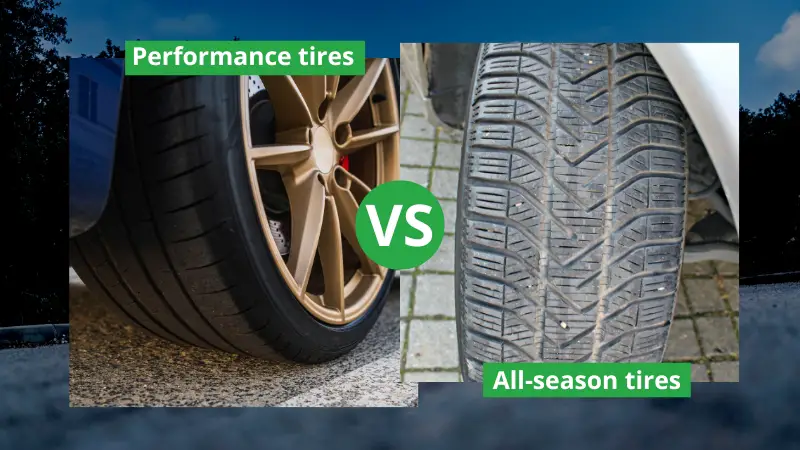When it comes to choosing the right tires for your vehicle, you may find yourself weighing the differences between performance tires and all-season tires.
Understanding their key characteristics will help you make an informed decision on which type is better suited for your driving habits and regional climate conditions.
Performance tires are designed to provide outstanding acceleration, maximum grip during cornering, and superior braking capabilities on dry or wet pavement.
On the other hand, all-season tires are built for year-round use and offer a well-rounded performance, with good traction in both dry and wet conditions, as well as acceptable snow traction in regions with light winter weather.
As you consider the performance and all-season tire options, remember to take into account your specific driving needs and the environment in which you typically drive.
Performance Tires: Key Characteristics

Traction and Handling
Performance tires, also known as summer tires, have a lower profile with stiffer sidewalls, offering better control and handling in tight curves compared to all-season tires.
Their design focuses on maximizing grip, especially on dry and wet roads, which results in an improved driving experience for you.
Temperature Range
When it comes to temperature range, performance tires perform best in warmer conditions. Their optimal functionality is usually above 45°F (7°C).
Below this temperature threshold, the rubber compounds in these tires tend to harden, making them less effective and potentially posing a risk on icy or snowy roads.
Tire Tread Pattern and Compounds
Performance tires possess unique tread patterns and rubber compounds that improve grip, cornering ability, and responsiveness in various driving conditions.
However, keep in mind that these tires are not designed for winter weather conditions or heavy snow as their tread design and hard rubber compound can lead to accidents on icy or snowy roads.
In comparison to all-season tires, performance tires typically have larger tread blocks and wider circumferential grooves. These features enable improved grip on both wet and dry roads, as well as better heat dissipation.
The rubber compounds used in performance tires are generally softer, allowing for better traction, but they may wear out quicker than those of their all-season counterparts.
All-Season Tires: Key Characteristics

All-season tires are designed to provide good performance in a wide range of driving conditions.
In this section, we will discuss the key characteristics of all-season tires, helping you understand their versatility, durability, tread pattern and compounds, and climate suitability.
Versatility and Durability
All-season tires provide a good combination of summer driving ability with added traction for winter weather.
They are designed to offer adequate performance in a variety of weather conditions and temperatures, making them a popular choice for drivers who experience mild season changes or prefer to use the same set of tires throughout the year.
The durability of all-season tires, as a result of their tread design and rubber composition, allows them to last longer and provide a smoother ride compared to specialized tires.
Tread Pattern and Compounds
The tread patterns and rubber compounds of all-season tires are carefully designed to provide a balance of traction, grip, and fuel efficiency. They typically have a moderate tread depth and a symmetric pattern, which helps in dispersing water and maintaining consistent contact with the road.
The rubber compounds of all-season tires are formulated to maintain flexibility in a wide range of temperatures, enabling them to provide adequate grip in both warm and cool conditions.
However, it’s essential to note that all-season tires may not deliver the same level of traction and grip as dedicated summer or winter tires in extreme conditions.
Climate Suitability
All-season tires are suitable for regions with mild winter conditions, where temperatures rarely drop below freezing. They can handle light snow and slush but may not be the best choice for areas with heavy snowfall or icy conditions.
In such cases, it’s recommended to switch to winter tires for optimum performance and safety during the colder months.
All-season tires work well for drivers who experience frequent climate changes, as they eliminate the need for multiple tire sets and the hassle of swapping tires between seasons.
Comparing Performance and All-Season Tires
In order to make an informed decision and choose the right tire for your vehicle, it’s essential to understand the key differences between performance and all-season tires.
This will help you weigh the pros and cons of each type of tire and determine which one best suits your driving needs.
Fuel Efficiency
Performance tires are designed for optimal handling, acceleration, and grip on dry or wet pavement. However, this increased grip can lead to reduced fuel efficiency as the tire compounds generate more rolling resistance, resulting in higher fuel consumption.
On the other hand, all-season tires offer a balance of performance and fuel efficiency, making them a more economical choice for everyday driving conditions.
Although they might not provide the same level of grip as performance tires, their lower rolling resistance can help you save on fuel costs in the long run.
Road Noise
One aspect to consider when choosing between performance and all-season tires is the level of road noise they generate. Performance tires are made of softer compounds, which can result in more road noise when compared to their all-season counterparts.
All-season tires generally offer a quieter ride due to their harder rubber compounds, which help dampen road noise and provide a more comfortable driving experience.
Tread Life
The tread life of a tire is crucial in terms of cost-effectiveness and overall performance. Performance tires, with their softer rubber compounds and aggressive tread patterns, tend to wear out faster than all-season tires.
However, they offer improved handling and responsiveness, which may be essential for driving enthusiasts or those who drive on twisty roads or in wet conditions.
All-season tires, on the other hand, provide a longer tread life due to their harder rubber compounds and more conservative tread patterns. This makes them a more practical and cost-effective choice for drivers who are looking for a long-lasting tire that can handle a variety of road conditions.
Ultimately, your choice between performance and all-season tires will depend on your specific driving needs and preferences. Consider factors such as fuel efficiency, road noise, and tread life when making your decision for the right tire.
Regardless of the type you choose, remember to regularly inspect and maintain your tires to ensure their optimal performance and safe operation.
Choosing the Right Tire

In this section, we will discuss how to choose the right tire for your vehicle, taking into account your driving needs, climate, and road conditions, as well as your budget and maintenance requirements.
By considering these factors, you can make an informed decision and get the most out of your tires.
Assessing Your Driving Needs
Before purchasing new tires, it’s crucial to determine your driving needs. If you’re someone who prioritizes performance and sporty handling, then performance tires might be the right choice for you. These tires offer better acceleration, grip during cornering, and efficient braking on both dry and wet pavement.
On the other hand, if you typically use your vehicle for casual driving and errands, all-season tires might be more suitable. These tires offer solid traction and a balanced performance for a wide range of driving conditions, though they might not be as designed for performance driving.
Considering Climate and Road Conditions
The climate and road conditions in your region significantly affect the right type of tire for your vehicle. All-season tires provide acceptable snow traction in regions with light winter weather.
However, if you live in an area with harsh winters or heavy snowfall, you may want to consider investing in a set of dedicated winter tires for better traction and safety.
If you live in a region with minimal precipitation, you may be able to use performance tires year-round, as they offer excellent grip on dry and wet pavement.
However, if you frequently drive in rainy conditions, consider all-season tires or even specialized wet-weather tires to improve resistance to hydroplaning.
Budget and Maintenance
When choosing between performance and all-season tires, you should also consider your budget and the maintenance costs. Performance tires tend to be more expensive initially, and their tread life might be shorter, requiring more frequent replacement.
All-season tires, on the other hand, tend to have a longer tread life and are typically more affordable, making them a cost-effective choice for many drivers.
Maintenance requirements also differ between tire types. Performance tires may require more frequent rotation and balancing, while all-season tires generally require less maintenance. Consider the cost of upkeep when making your decision.
By assessing your driving needs, considering the climate and road conditions in your region, and evaluating your budget and maintenance requirements, you can choose the right tire for your vehicle and driving preferences.
Conclusion
In conclusion, the choice between performance and all-season tires ultimately depends on your driving needs and preferences. If you prioritize handling, responsiveness, and grip in dry and wet conditions, then performance tires may be the right choice for you.
On the other hand, if you’re looking for well-rounded tires that deliver balanced performance for everyday driving in various conditions, including light winter weather, all-season tires are likely the better option. They are a practical solution offering longer tread life and year-round usability.
It’s important to consider factors like your local climate, driving habits, and your vehicle’s performance capabilities when making a decision.
Weighing the key differences between performance and all-season tires can help ensure you make an informed decision to enhance your driving experience and promote safety on the road.
Hi, my name is Niklas, the head content creator & CEO of Whirling Wheelz. I am very interested in vehicles of all kinds, mainly cars. I have a car mechanics degree from high school and a big hobby of mine is to follow the WRC (World Rally Championship) both online and through travel.


